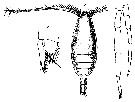|
|
 |
Fiche d'espèce de Copépode |
|
|
Calanoida ( Ordre ) |
|
|
|
Clausocalanoidea ( Superfamille ) |
|
|
|
Phaennidae ( Famille ) |
|
|
|
Phaenna ( Genre ) |
|
|
| |
Phaenna zetlandica T. Scott, 1902 (M) | |
| | | | | | | Ref.: | | | T. Scott, 1902 (p.445, 453: Descr. M, figs.M); van Breemen, 1908 a (p.222, figs.M); Rose, 1933 a (p.126, Rem.); Park, 1983 a (p.318: Rem.); Andronov, 2013 (Rem.: p.369) |  Issued from : T. Scott in Rep. Fishery Bd Scotl., 1902, 20 (3). [Pl. XXII, Figs. 5-7]. Male (from Shetland Islands): 5, habitus (dorsal); 6, P5; 7, terminal part of P5. Prosome about equal to half the length of body. Abdomen narrow, its length is equal to little more than 1/3 of that of prosome; 5-segmented. Genital segment slightly longer than any of the others abdominal segments. Anal segment very short. Caudal rami very short. A1 appear to be the same on both sides, do not reach to the end of the abdomen; first 6 segments short, 7th, 8th and 9th partly coalescent, 10th to 15th segments of moderate length, sub-equal, 17th segment also nearly equal to these length, but the remaining segments rather shorter. P5 very simoilar to those of Phaenna spinifera. The right leg is elongated and slender and 4-segmented, the first three are of nearly equal in length, but the last is about one and a half times the length of the preceding segment and considerably attenuated so as to resemble a spine rather than a segment. The left leg is rather longer than the right one and apparently 5-segmented; the terminal portion consists of 2 appendages, the inner one being short and moderately broad, rounded at the end and fringed with setae, the other is narrow and longer than the inner one and forms with it a kind of finger and thumb-like arrangement (fig.7). P5 are seen to differ somewhat from the male of Phaenna spinifera especially in the terminal part of the left leg when compared with the figure of the male P5 in Giesbrecht.
| | | | | NZ: | 1 | | |
|
Carte de distribution de Phaenna zetlandica par zones géographiques
|
| | | | Loc: | | | N Atlant. (Shetland Is.) | | | | N: | 1 | | | | Lg.: | | | (1129) M: 2,5; {M: 2,5} | | | | Rem.: | Species doubtful. Pour Rose (1933 a, p.126) il est possible que le mâle décrit par T. Scott soit le mâle d'un Xanthocalanus. Andronov (2013) note que le rapport de la longueur du prosome à sa largeur est légèrement supérieure à 2.4. le cephalon et le segment thoracique 1, les segments thoraciques 4 et 5 sont fusionnés, alors que chez le mâle de P. spinifera ils sont séparés comme chez la femelle. La partie distale de l'avant dernier segment de la P5 gauche chez P. spinifera possède une lame assez grande et large, et n'est pas séparée du segment, tandis que chez P. zetlandica elle en est séparée. Une structure similaire de l'extrémité distale de la P5 gauche du mâle existe au moins chez Xanthocalanus kurilensis (see Vyshkvartzeva, 2002, fig.43) et Xanthocalanus sp.2 (see Grice, 1972, fig.145-146). Ces arguments permettent d'affirmer que le mâle de zetlandica n'appartient pas au genre Phaenna. | | | Dernière mise à jour : 13/03/2015 | |
|
|
 Toute utilisation de ce site pour une publication sera mentionnée avec la référence suivante : Toute utilisation de ce site pour une publication sera mentionnée avec la référence suivante :
Razouls C., Desreumaux N., Kouwenberg J. et de Bovée F., 2005-2025. - Biodiversité des Copépodes planctoniques marins (morphologie, répartition géographique et données biologiques). Sorbonne Université, CNRS. Disponible sur http://copepodes.obs-banyuls.fr [Accédé le 13 décembre 2025] © copyright 2005-2025 Sorbonne Université, CNRS
|
|
 |
 |




